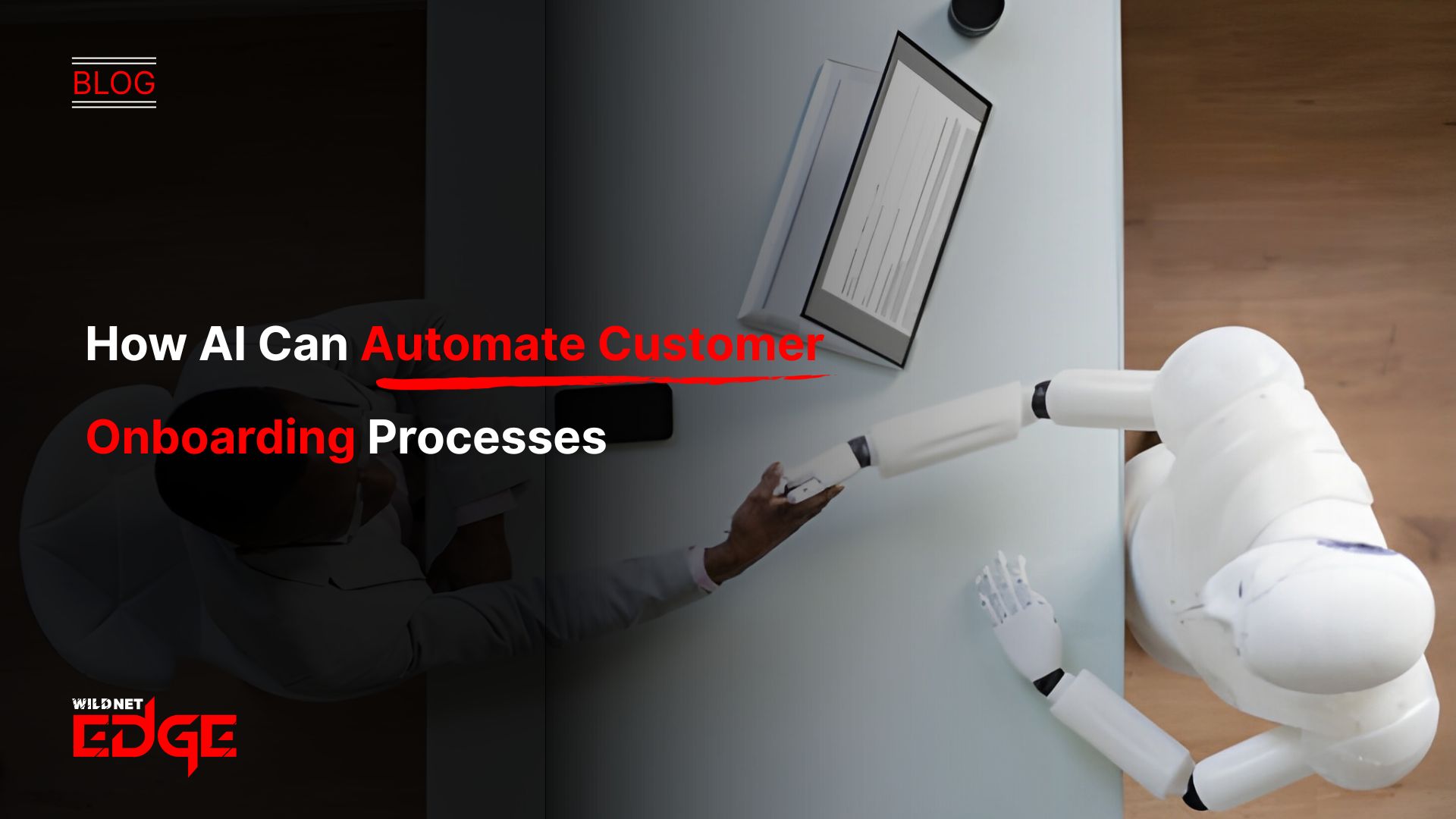TL;DR
This article explains how AI is revolutionizing customer onboarding through automation and personalization. AI-driven onboarding adapts to user behavior, offering intelligent chatbots, automated KYC verification, and proactive guidance to speed up user activation. For businesses, it reduces churn, cuts support costs, and accelerates customer time-to-value.
The first few days of a customer’s journey are the most critical. A slow, confusing, or impersonal onboarding process is the number one cause of early churn. It’s a leaky bucket that costs your business revenue. By leveraging AI in customer onboarding, you can transform this vulnerability into a powerful, automated engine for customer success, ensuring users find value from day one.
The Problem with Traditional Onboarding
Gradually, for several decades, the onboarding of customers has been mainly a manual or universal application process. New users had either to be transferred to a human implementation specialist, which is an expensive and non-scalable option, or to receive a series of welcome emails, which is a cheapest method and not tailored to the user’s individual needs or objectives.
The traditional method has major flaws at its core:
- It is Slow: Manual operations or waiting for a predefined demo call result in a long delay in a customer’s “time-to-value” (TTV).
- It is Inefficient: Your costly customer success and support teams will be occupied with repetitive and time-consuming setup tasks.
- It is Impersonal: A universal workflow neglects the fact that a user in one role (e.g. an admin) needs very different support than a user in another role (e.g. a daily user).
- It is Reactive: The customer is expected to find help only after he/she has already been stuck, at which point, the customer has already become somewhat frustrated.
What is AI-Driven Onboarding?
The onboarding process powered by AI creates a personalized, automated, and interactive journey for each and every new user. It is not a static flow, but rather a dynamic one that changes according to the user’s data (like industry, role, or company size) and their actual behavior in the application at the moment.
It is like the difference between providing every new user with the same generic map and supplying each user with a personal GPS that leads them to their unique destination. This method of automating the customer journey is the main factor in making AI in customer onboarding the driving force for scalable customer success strategies.
Benefits of AI in Customer Onboarding
For a business leader, investing in an AI-powered onboarding process delivers a clear and significant return on investment. Choosing AI in customer onboarding allows organizations to create intelligent, adaptive experiences that scale effortlessly.
Dramatically Reduced Time-to-Value (TTV)
AI-powered guides and interactive tutorials can help users complete setup and experience the product’s core value (the “aha!” moment) in minutes or hours, not days or weeks. This immediate value reinforcement is critical for long-term retention. This is one of the most effective ways to Automate Business Processes that directly impact the customer. Businesses leveraging AI in customer onboarding consistently report faster activation rates and improved satisfaction.
Significant Reduction in Early Churn
The highest churn rates for SaaS and app businesses occur within the first 30–90 days. A smooth, personalized, and proactive onboarding experience directly combats this. It reduces user frustration, builds confidence, and ensures users are successfully “activated,” making them far less likely to abandon the product. Companies using AI in customer onboarding often see double-digit improvements in retention metrics due to personalization and automation.
Lower Customer Support Costs
AI chatbots and in-app guides can handle the vast majority of common, repetitive “how-to” questions that plague support teams during onboarding. This deflects a significant volume of tickets, allowing your human support agents to focus on more complex, high-value customer issues. The result: a scalable system where AI in customer onboarding cuts operational costs while maintaining human-level responsiveness.
Scalable and Consistent Experience
A human-led onboarding team can only handle so many new customers at once. An automated system can provide a high-quality, consistent onboarding experience for one new user or ten thousand new users simultaneously, ensuring consistent quality as your business scales — one of the biggest advantages of AI in customer onboarding for growing enterprises.
Core Applications of AI in the Onboarding Process
AI is not a single tool; it’s a set of technologies that can be applied at different stages of the onboarding journey. By strategically applying AI in customer onboarding, businesses can transform each step of the user journey into an intelligent, data-driven process.
Intelligent, Interactive Chatbots for Setup
An AI Virtual Assistant can act as a 24/7 onboarding concierge. It can conversationally guide a user through setup, answer their questions in real time (“How do I add a new team member?”), and even collect necessary information to configure their account.
Personalized Onboarding Paths
Upon sign-up, AI can analyze user data (from the sign-up form, CRM, or data enrichment tools) to determine their role or primary goal. It can then present a unique onboarding checklist or tutorial path that is most relevant to them, skipping steps they don’t need.
Automated Data Verification (KYC/AML)
In industries like FinTech or insurance, onboarding involves verifying customer identity (Know Your Customer) and is often a slow, manual bottleneck. An AI Automation Agency can build solutions using AI-powered OCR (Optical Character Recognition) and computer vision to instantly scan and verify ID documents, dramatically accelerating the compliance process from days to minutes.
Proactive User Nudging
AI can monitor user behavior within the app to identify when a user is “stuck” or has failed to adopt a key feature. If a user hasn’t invited a teammate after three days, the AI can trigger a proactive, contextual tip (via in-app message or email) suggesting they do so and explaining the benefit.
Case Studies
Case Study 1: A B2B SaaS Company’s Activation Boost
- The Challenge: A project management SaaS company had a high churn rate in the first 7 days. Analytics showed users were signing up but failing to create their first project or invite team members.
- Our Solution: We developed an AI-driven, in-app onboarding flow. The system analyzed the user’s role (e.g., “Manager” vs. “Team Member”) and guided them through a personalized setup checklist. Proactive nudges were triggered if key activation events weren’t completed within 24 hours. This required building AI-driven onboarding logic directly into their platform.
- The Result: The user activation rate (creating a project and inviting a teammate) increased by 60% in the first week. This led to a 25% reduction in 30-day churn, as users were now properly embedded in the product — a clear example of the power of AI in customer onboarding.
Case Study 2: A FinTech App’s Automated KYC
- The Challenge: A new digital bank had an entirely manual process for identity verification, taking up to 72 hours to approve new accounts. This slow process was causing a massive drop-off rate during signup.
- Our Solution: We implemented an AI-powered data verification system. Users uploaded a photo of their ID, and the AI used OCR to extract the data and computer vision to verify its authenticity, cross-referencing it with other data points. This was one of our highly specialized Custom Software Solutions.
- The Result: The account verification and onboarding process was reduced from 3 days to under 3 minutes. The sign-up completion rate nearly doubled, dramatically improving their customer acquisition metrics through smarter AI in customer onboarding workflows.
Our Technology Stack for AI Onboarding
We use modern, scalable technologies to build these intelligent systems that drive AI in customer onboarding innovation.
- AI & NLP Frameworks: Google Dialogflow, Microsoft Bot Framework, Rasa, OpenAI (for chatbots)
- Computer Vision & OCR: Google Cloud Vision AI, Azure Form Recognizer, OpenCV
- Data & Analytics: Mixpanel, Amplitude, Python (Scikit-learn, TensorFlow)
- Integration Platforms: Zapier, MuleSoft, Workato
- Cloud Platforms: AWS, Google Cloud, Microsoft Azure
Conclusion
Ultimately, AI in customer onboarding is the key to scaling customer success effectively. By automating repetitive tasks and personalizing the user journey, you ensure that every new customer feels valued and achieves their “aha!” moment faster, dramatically reducing churn.
Ready to transform your onboarding from a leaky bucket into a high-retention engine? At Wildnet Edge, our AI-first approach ensures we build intelligent, automated systems. We are your expert partner in designing an AI-driven onboarding experience that delivers measurable business results powered by the best practices in AI in customer onboarding.
FAQs
You can justify the investment by calculating the ROI based on two key areas: cost savings (reduced support tickets, lower headcount for manual onboarding) and revenue gain (increased customer lifetime value due to a measurable reduction in early churn).
A simple AI chatbot integration to answer common questions can be done in a few weeks. A more complex, fully personalized, in-app guidance system with proactive nudges might take 3 to 6 months to design, build, and train properly.
This is a common concern, but a well-designed AI assistant feels helpful, not robotic. The key is to be transparent that it’s an assistant, ensure it’s highly accurate for the tasks it can handle, and provide a seamless, one-click escalation path to a human agent for complex issues.
You can start simply with data from the signup form (e.g., user’s role, company size, stated goals). As you grow, you can integrate data from your CRM or product analytics (e.g., features used, pages visited) to create even more dynamic and relevant onboarding journeys.
A great quick win is using AI-powered OCR for data verification (if your industry requires it). Automating the “check ID” or “read document” step can save hundreds of manual hours and dramatically speed up a major bottleneck.
AI excels here. It can act as an intelligent checklist, ensuring every single required step is completed in the correct order, verifying document uploads in real-time, and creating a perfect, automated audit trail for compliance officers. This is far more reliable than manual tracking.
The biggest mistake is a “one-size-fits-all” automation. Sending the exact same sequence of emails and tutorials to every single user, regardless of their role or needs, is just a faster way of being impersonal. The real power of AI is in personalization.

Nitin Agarwal is a veteran in custom software development. He is fascinated by how software can turn ideas into real-world solutions. With extensive experience designing scalable and efficient systems, he focuses on creating software that delivers tangible results. Nitin enjoys exploring emerging technologies, taking on challenging projects, and mentoring teams to bring ideas to life. He believes that good software is not just about code; it’s about understanding problems and creating value for users. For him, great software combines thoughtful design, clever engineering, and a clear understanding of the problems it’s meant to solve.
 sales@wildnetedge.com
sales@wildnetedge.com +1 (212) 901 8616
+1 (212) 901 8616 +1 (437) 225-7733
+1 (437) 225-7733































